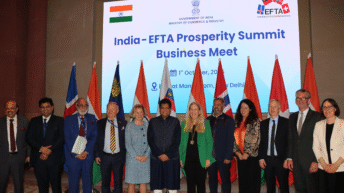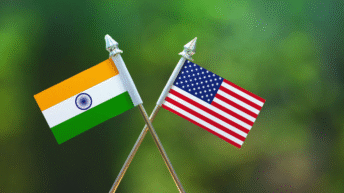By Rajeev Srinivasan

Can the Prisoner’s Dilemma theory explain the evolution of India’s tit-for-tat foreign policy?
Keywords: Prisoner’s Dilemma | Game Theory | India-China-Pakistan | Tit-for-Tat | Strategy | Rational Actors | Escalation | Betrayal | Cooperation
The game-theory construct of the Prisoner’s Dilemma is well-known as a model for behaviour in the absence of full information or trust. Two actors, A and B, are accused of a crime; and they can either cooperate with or betray the other. Neither actor knows what the other will do as they are held incommunicado. If A betrays B and vice versa, both get penalized moderately. If A betrays B and B cooperates (remains silent), then A gets a good payoff (reward) and B gets penalized heavily. If both cooperate (with each other), both benefit: neither gets penalized.
Cooperation produces the optimal outcome, but rational players will gauge the downside risk of being betrayed more heavily than the upside benefit of cooperation, which leads to a surprising outcome: if you intend to play this game once, the best tactic is to betray the other party.
But if one plays this game repeatedly, then it is not clear what the long-term strategy is. All sorts of elaborate strategies have been developed and simulated in millions of computer interactions, and it turns out, slightly surprisingly, that ‘tit for tat’ is the best strategy so far devised. That is, A starts off by cooperating; B responds. In the next round, A does whatever B did in the first round.
Foreign policy can be modelled as an endless Prisoner’s Dilemma. Thus, in each interaction, there is a choice of cooperating or betraying the other side. Based on the fallout, various lessons are learned, and then it’s onwards to the next round–talks, war, whatever.
It appears that PM Narendra Modi takes a game-theoretic Prisoner’s Dilemma view of foreign policy. He starts off with cooperation, and if that doesn’t work, he reverts to the ‘tit-for-tat’ strategy. In many cases, it is necessary to inflict pain on the other side to get your point across.
With Pakistan, there was the initial bonhomie with Nawaz Sharif, including the surprise trip to that country. Cooperation. This was repaid by a series of attacks, including Pathankot and Pulwama. Betrayal. The Indian response? Uri. Balakot. Betrayal, tit-for-tat. If Pakistan were a rational player, it would note that the long-term nuclear escalation theatrics are in tatters, and with the abrogation of Article 370 Modi has the upper hand on them on Kashmir as well.
Similarly with Malaysia and Mahathir Mohammed, India displayed initial friendliness, but when Malaysia began its Pakistan-Malayasia-Turkey axis talk, they were hit with the palm oil ban. The message got across. Similarly for Turkey, their $2.3 billion contract for building fleet support vessels was frozen in October. (To my surprise, it was given a go-ahead in March this year, which rather damages my thesis of measured tit-for-tat responses. However, Turkey has toned down the rhetoric.)
The same approach, broadly, was extended to the US too. Initial outreach to Obama, despite the fact that Obama’s regime had not overturned a visa ban on Modi, making him the only leader thus humiliated under some obscure law, throughout its tenure. Later bonhomie with Trump. On average, the result has been continued cooperation by both parties, to mutual benefit, despite irritants like the withdrawal of the Generalised System of Preference (GSP) benefits and the recent H1-B visa ban.
If this hypothesis is correct, we are now reaching a point where Modi has decided that a little betrayal of the Chinese is in order, after a series of cooperative moves by him, followed by betrayals by them. There were the summits in Wuhan and Mahabalipuram. Chinese betrayals included the Financial Action Task Force (FATF) move to shelter Pakistan, the refusal to let India into the Nuclear Suppliers Group, and the refusal to allow some Pakistanis to be declared terrorists.
The Indian side responded; India was the only nation that stood up and said “Absolutely not!” to the entire BRI story. It has, even though belatedly, begun to eliminate Huawei from consideration in large telecom deals. And at least now, after the clashes, Chinese L1 bidders are finding their bids being disqualified for large projects.
One of the criticisms against Modi is that he has continued the old policy of fruitlessly appeasing the Chinese, and has not responded in kind. Mohan Malik, in a tweet, said, “The debate is over. Xi’s crushed Modi’s $5 trillion eco plan by ‘24”. In an essay in Open magazine, Brahma Chellaney said, “India needs to make a fresh start by abandoning its accommodating approach toward China that has made it look like a meek enabler. After spending so many years on the defensive, India must discard the platitudes and retake the narrative.”
The outcome may well be that India, instead of waiting passively for China to strike at leisure, actually takes the initiative in pre-emptive strikes where India has an advantage. This could be risky and could lead to escalation, but history suggests that when India stands up to China, the latter retreats, as is normal for a bully. We may see an Indian strike in Tibet in the near future. That would be most obviously ‘tit-for-tat’. This is in addition to the boycott and trade war. The removal of 59 Chinese apps from the Play Store and the go-slow customs activity on incoming Chinese goods are signals of a new determination.
And so was the Prime Minister’s rousing speech in Leh. In addition to the messages of support to the front line troops, there was no ambiguity in the speech. Without naming names, he declared that the age of expansionism was over. Even more tellingly, he referred to Sri Krishna’s Sudarsana Chakra, and the implication was clear: the story of Sisupala, one hundred of whose transgressions the Lord forgave, before beheading him with the disk-like weapon.
There is a time of reckoning for the wicked, the PM implied; and also, while the mills of karma might grind slowly, they do grind exceedingly small.






Very well elaborated, hope to get more such article in future. Liked the ‘game theory of prisoner’s dilemma.
Hats off to PM Modi
India has never been so much prepared for war, higher we climb more stable will be the peace
PM has gone step by step
we has never accounted for China’s betrayals and we gave them a long rope
a strike is next logical step (if needed) Strike when we are in an advantage position
If there is an escalation be ready for losses but China will retreat in all probability
solve Nepal problem and an air strike on Tibet cannot be ignored
have a road map for POK/Gilgit Balistan
China knows it is on the wrong side as Pak has traded Indian land to them
Our population bothers them
Some training will give both of them sleepless nights
The statement in the article: “The outcome maybe well that India instead of waiting passively for China to strike at leisure, actually takes in preemptive strikes where India has an advantage…the latter retreats, as is normal for a bully.”— is more of bravado and wishful thinking! India is a democracy, unlike China– a Communist country, to make such irresponsible aggression. India has many internal matters to address to. PM Modi’s foreign policy of be-friending nations was and is, a good one. Particularly, in the case China, it did not help. After all, in the famous adage of: Saam, Daan, Bhed, Dhand , India applied the first. After becoming self-sufficient and economically robust, India could combat China, only when India is attacked or ingressed.